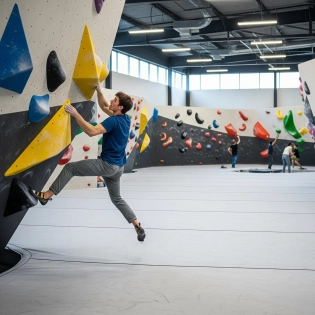
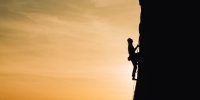

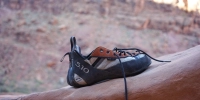
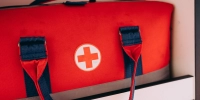


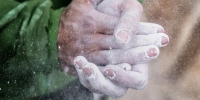
Climbers Point
There are a few scenarios in which climbing shoes may hurt:
1. If you are a new climber, and you are not used to climbing shoes
If you are a new climber, and you are not used to climbing shoes, they may hurt at first and be very uncomfortable. Climbing shoes in general are not very comfortable, and this sometimes causes pain to seem much worse than it is for beginners. After a few sessions, new climbers usually get used to the feel of climbing shoes. It's recommended to start out with flat or beginner level shoes, as the more aggressive climbing shoes can be difficult to get used to from the start and may be much more painful than flat beginner shoes.
2. If your climbing shoes are new and they haven't broken in
Climbing shoes that are new and haven't broken in is a very common reason for painful shoes. This is especially true if you downsize your climbing shoes. Once your shoes are broken in, the pain should be reduced or eliminated completely. If it is not, your shoes may just not be the right size or shape for your feet.
3. If your climbing shoes are just not right for your feet
Another common reason for feeling pain in climbing shoes is if you bought shoes that are not the right size or not the right shape for your feet. Feet come in all shapes and sizes, as do climbing shoes. Not all climbing shoes fit all shoes. Many new climbers decide to get what most others in their climbing gym say are the best shoes, or they get what they see most others wearing. Just because most wear them, doesn't mean they match your feet, and this is something many climbers don't realize.
It's important to get the shoes that match your feet and at the right size. If you have wider feet, get wider shoes. If you have narrow feet, get narrower shoes. There are shoes that are made specifically for wider and narrower feet, such as the Mad Rock Drone, they have a high volume version for wider feet climbers, and a narrower version for narrower feet climbers.
Find what works for you, not what works for others.
Climbers wear small sized shoes because climbing shoes are meant to be very minimal and snug. When climbers wear climbing shoes that are slightly smaller than their actual shoe size, these attributes are slightly enhanced, as is the performance a climber can gain from wearing smaller climbing shoes.
This can be a double-edged sword, though. If a climber wears climbing shoes that are too small, they may not gain any of the benefits climbing shoes provide, and may actually worsen their performance, not to mention injure or damage their feet.
Finding the right climbing shoes and the right size are not as simple as some may think. It takes going through a few shoes and trying new ones out until you find the right pair for you.
Your toes should be slightly curled inside the shoes, though, this depends on how aggressive the shoes are, the size of the shoes, and the shape of them.
If you have wide feet, you should try to find shoes that are wider and have a wider toe box. If you have narrower feet, you should find shoes that fit a narrow foot shape. This all makes a difference in how your foot will look and feel inside the shoes.
Climbing shoes should be snug enough to not have dead space in them, but not so snug that you feel throbbing pain and can't even walk or climb in them.
Climbing shoes are designed for being snug and minimal to help with footwork, this includes standing on tiny holds, and pulling your weight with your feet. If your climbing shoes are not snug and tight enough, your feet may move inside of them, which can make it much more difficult to pull your weight and stand on small holds.
Listen to your body and your feet, if it's too painful, go up a size or find different shoes that fit your feet. Having extremely tight shoes is not the answer if it reduces your performance.
Climbing shoes should be snug, with as little to no dead space in them as possible. They should not be painful though. Slight pain when they are new is normal, but pain that lasts even after their break in period and after you take them off is not supposed to happen.
If you want to clean your climbing shoes by brushing them, make sure the brush won't damage your shoes. Using wire brushes or steel brushes could damage the fabric, rubber, and other materials used in the climbing shoes.
For most situations, a damp cloth is enough to clean climbing shoes very well, but if you have something a little bit more stubborn, a climbing brush could also do the trick.
Climbing doesn't really target your chest muscles that much. There are situations in which you will need to push your weight up with your hands, which will utilize your chest muscles, but not really to the point where it will strengthen them that much.
It's best to supplement your climbing with chest targeted exercises, such as the bench press, so that when you get to climbing moves that you need to push your body up, you will have the strength to do it.
If climbing is a sport that you enjoy and are motivated by and it causes you to change your habits and exercise more, then yes, climbing can be a great way to help you lose weight.
Exercise in general is a great way to help you lose weight, but it really comes down largely to your diet. With that said, if you reduce your calorie intake but are not active at all, the journey is going to be less efficient. So both aspects really go together.
Which brings me to my first point. If climbing motivates you to change your habits, improve your lifestyle, eat healthier, and exercise more, then yes, climbing can very much help you lose weight.
Rock climbing shoes are designed to be worn without socks, to have as little wiggle room and dead space in them as possible. Socks can cause your feet to slip and move around a little bit inside of the shoes, which could reduce your performance.
Most climbers don't wear socks with climbing shoes, but many do. If your shoes are a little bit too big, a thin pair of socks can help fill in that extra dead space. A thin pair of socks can also help reduce friction in new climbing shoes, which could help reduce blisters and other sore spots.
To mention rental shoes, while I have never worn rental shoes and will chose to never wear them if I have the choice due to not wanting to wear something so many sweaty and stinky feet have been in, socks could be a great choice. If you are like me and are more than slightly grossed out by rental shoes, wearing socks can give an nice extra layer between you and the shoes.
I don't know his actual connection to the sport or its origin, but, from the very few videos of him climbing and talking about it, you can see how much he loves the sport.

